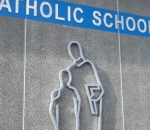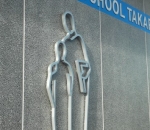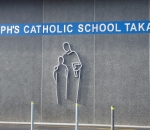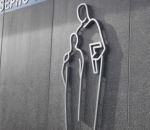Our Living and Learning Focus continues as
CARE ATAWHAI KUMANU
Our School Values are
Tina Justice, Pono Truth, Aroha Compassion, Manaakitanga Hospitality and Tapu Respect for the Environment
Lived out in our Motto
Courtesy Care Co-operation Courage
The Learning Model for our school is: “To Know To Do To Use”
Learning to Learn at St Joseph’s #L2L




The latest development on our school building is a beautifully crafted artwork designed by Valentina Abba and created by St John the Baptist Studio:
St Joseph the Worker, caring for Jesus and us.
This is a strong reminder to us all, as we arrive at school,
that we are under the patronage of St Joseph.
It reflects our motto of Courtesy Care Co-operation Courage.
It also reflects our Mercy values of Aroha Compassion and Manaakitanga Hospitality.
We are also grateful to the late Mary Thomas, whose generous bequest to the school, enabled us to proceed with this project.
P.S. Joseph is holding a Carpentry Square, an essential tool for building things that are square (or at exact angles).
A builder needs to be careful and exact with every aspect of the build. The framing square which Joseph holds can be used from small crafts to big structures. He is prepared for any job-big or small!
Cultural Connection-Here Comes Everybody
The word catholic means “universal.” Someone once described being Catholic, as “Here comes everybody!”
In Acts of the Apostles 10:34-36, we hear that God shows no partiality; neither should we. Even so, it is sometimes easier to stick with people who are similar to us. They understand us and know where we are coming from. There’s less explaining to do. Right?
But being catholic means reaching out of our familiar circle of friends and including in our group people of different cultures and religions.
Have you ever seen a Native American blanket? Threads of various colours are woven together to form an intricate, new patter. Each blanket is completely different from every other blanket. By building relationships with people of different cultures and embracing the diversity, we become like one of the threads in such a blanket, weaving our uniqueness’s in a new and beautiful pattern. The result is different and enriching, and then we become truly catholic.
In Religious Education Learning, the teachers and children are focusing on the Church and what is means to be Church. The main themes are: Belonging, Gathering, Celebrating, Living, God’s Presence, the Call to be like Jesus, the Call to Service, the Call to Celebrate, The Church as a Pilgrim People on the journey of Life – Te Wa.

An opportunity to be part of the Belonging, Gathering, Celebrating Church occurs this coming Sunday at St Joseph’s Parish Church at the 10.00 a.m. Mass. Please do join the children and the parish on this day.
Teaching and Learning for the 21st Century
Here is some additional information for all who are interested in why education needs to develop and change. I have again inserted some reading into our newsletter.
The extract below is taken from Core Education Thought Leadership
Ten Trend categories

ECONOMIC
Computational thinking
“Over the past few decades, we’ve seen the impact that computers and automation have had on all facets of life. Advances in computer processing power and Internet connectivity have changed the nature of work and the skills required for a large number of occupations.

These now require the development and use of computational thinking – a way of solving problems, designing systems, and understanding human behaviour that draws on concepts fundamental to computer science. The term “computational thinking” can be thought of as shorthand for “thinking like a computer scientist.”
To flourish in today’s world, computational thinking must be a fundamental part of the way people think and understand the world. Computational thinking is more than being able to interact with computers in our everyday lives, it’s about having the know-how and the confidence to look beyond the applications we use to the code beneath. It’s about using technology to create from the ground up, not just consume.
Computational thinking (CT) is a problem-solving process that includes (but is not limited to) the following characteristics:
- Formulating problems in a way that enables us to use a computer and other tools to help solve them
- Logically organising and analysing data
- Representing data through abstractions such as models and simulations
- Automating solutions through algorithmic thinking (a series of ordered steps)
- Identifying, analysing, and implementing possible solutions with the goal of achieving the most efficient and effective combination of steps and resources
- Generalising and transferring this problem solving process to a wide variety of problems

These skills are supported and enhanced by a number of dispositions or attitudes that are essential dimensions of Computational Thinking. These dispositions or attitudes include:
- Confidence in dealing with complexity
- Persistence in working with difficult problems
- Tolerance for ambiguity
- The ability to deal with open ended problems
- The ability to communicate and work with others to achieve a common goal or solution
More of the teaching and learning in our schools needs to be devoted to this kind of knowledge and skill development. It’s not just student’s technical skills that benefit from this type of learning. The spill over is that students develop better ways to approach and think about problems, which is just as valuable as the technical skills themselves.
Much of what we’ve focused on in schools in the past can be described as computer literacy. A future focused curriculum must teach children the fundamentals of computer science, information technology and digital literacy – teaching them how to code, and how to create their own programmes; not just how to work a computer, but how a computer works and how to make it work for them.
This is the essence of computational thinking, and it is something that should be included at all levels of our schooling system – not simply as an afterthought associated with the preparation of senior secondary students for the world of work. Taking this on board will require some serious thinking about the priorities we have in our schools and our curriculum, including:
- how can we incorporate computational thinking into an already crowded curriculum?
- how do we train a generation of teachers who have no background in this sort of thing?
- how will we assess this – and where does it ‘fit’ within our competency framework?”

I am very optimistic that the teaching and learning here at St Joseph’s has a strong emphasis on children developing the skills and competencies needed to become computational thinkers. However, the ideas in the article do challenge us to continue to develop our own thinking and practice so that we provide relevant and pertinent learning experiences for our students that may well be very different from what we currently do.
Remember!
Alphonsus (Yellow) and Pompallier (Blue) House Family Mass is at 10.00 a.m. on Sunday 26 June
All families are welcome!
Remember also the High Tea, which starts after the 10.00 a.m. Mass on the 26 June!
St Joseph’s Catholic School Board of Trustees
The first meeting of the new Board is at 7p.m. on Thursday 23 June.
Have a lovely weekend!
Ka kite ano!
Phil
